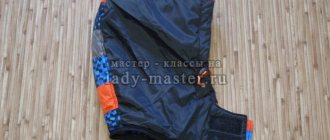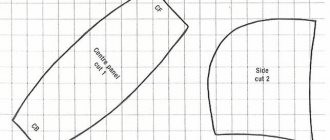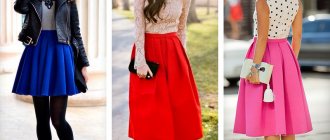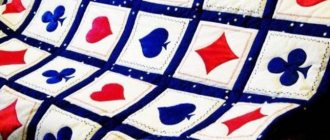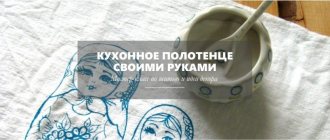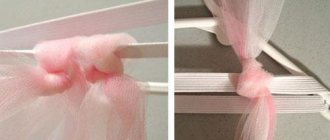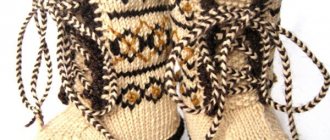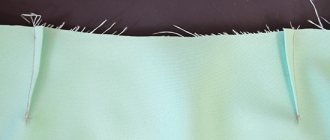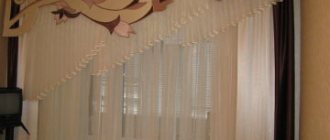Well friends, hello everyone. Today it’s time for an article that will be useful to all needlewomen, namely those who are planning to have a child, or are already in the first months of expecting their baby.
In addition to the fact that the expectant mother is faced with many new tasks: how to lead a healthy lifestyle so that the baby is born healthy, she must also not forget to take care of her appearance - to look beautiful. It's no secret that a growing belly turns pregnant women into hippos, and a woman wants to remain attractive and please her other half as before.
Therefore, most of us start shopping - in special departments for pregnant women, where prices are mostly steep, and we don’t really want to invest in an expensive thing that will not last long. And in markets where cheap maternity clothes are sold, they look like a sack of potatoes.
Therefore, in this master class I will show you how to quickly and easily make stylish clothes for pregnant women with your own hands. This is not such a difficult task at all, I think a novice seamstress can handle it, the main thing is a positive attitude and a sewing machine with a basic set of tailoring tools. And since it’s a cold winter month outside, I’ll be sewing maternity pants.
All we need are your pants or the trousers that fit you before pregnancy. We will remake the finished item to suit the growing tummy. At the end of the master class, I will tell you how to return them to their original appearance, so that after giving birth you can enjoy your trousers again.
For the makeover, I'll take my thick wool leggings, which I was comfortable in before my belly started growing during my fourth month of pregnancy.
Digging a little from the topic, I want to say that while pregnant, I continued to lead an active lifestyle and the whole family went on a cycling trip around Abkhazia. By the way, I then calmly carried my child on the back seat of my mountain bike (my daughter weighed about a little more than 25 kg.)
Our road trip around Abkhazia - I’m three months pregnant
I was lucky that I tolerated the pregnancy well and was able to complete two trekking trips to mountain peaks with my husband – both at an altitude of about 2000 meters. These are the boasts from me, so if you feel great, you shouldn’t limit yourself to physical activity and active pastime.
Trekking trip through the mountains to the most inaccessible beach on the island of Koh Phangan, Thailand - my first month of pregnancy
What are the best maternity jeans?
Everyone is interested in which maternity jeans are more comfortable and better. This can only be determined by the woman herself after trying it on. In total, there are 4 types of models designed specifically for this period, and each of them has its own characteristics.
- Without elastic inserts, with a special fit under the belly: the back of the belt is raised, the front is lowered along the bikini line. The belt has various adjustment options. These pants are recommended to be worn from the beginning of pregnancy to 7 months.
- With an elastic insert, with a special fit under the belly. The elastic waistband provides comfort at any time. These pants will also serve after childbirth.
- With an elastic belt, with a special fit on the stomach: a wide elastic belt acts as a bandage. It is considered the most universal design that will suit everyone from the beginning to the end of pregnancy.
- With an elastic waistband and a high rise: the belt covers the entire belly, stretching like a stocking. The main advantage is wearing it in the cold season. The problem is whether maternity jeans of this model are comfortable in the summer: most likely, they will be too hot. In addition, they can only be worn with long sweaters, and they cannot be used at all until 4-5 months due to the large insert.
The question of which jeans are best for pregnant women must be approached from the perspective of the timing and individual preferences of the woman.
How to alter maternity jeans
To do this, we will need old jeans, a piece of thick elastic knitwear approximately 50 centimeters long with a fabric width of 150 centimeters, scissors, thread, a sewing machine and a little patience. You can buy knitwear, or you can use an old unwanted T-shirt or the top of knitted tights for these purposes. It’s better not to be greedy and still buy the material, since the comfort of wearing will depend on how elastic the knitted insert is, and this, you see, is very important.
So, we take the jeans, use fabric chalk to mark the excess - the part that no longer meets on the stomach and cut it off at the back along the yoke line of the jeans, at the front - in a semicircle. Don't forget to leave a 1 centimeter allowance! The zipper must either be cut off completely, or torn off and the fly carefully sewn up. We carefully tear off everything that prevents us from making an even cut.
Main job
First you need to determine your dimensions and clothing parameters. After this, measure the width of the inserts and mark them on the fabric. Make the necessary markings on the sides of the jeans and cut out the material.
After this, place the cut out parts of the jeans onto the insert material and cut them out as well.
Pins will be used to secure the material. They will also come in handy when finished inserts need to be sewn to the sides.
For those who are thinking about a New Year's look: 8 hairstyle options
Traditional, chic or following the classics: holiday table decoration ideas
How to wash jeans to make them a size smaller
Before every New Year I make a mask of 3 simple products. Rejuvenates overnight
You can also sew on a machine, it all depends on your skills. I did this by hand, although the jeans are thick, it doesn't take much time.
I made inserts on the sides above the pockets so that the other fabric would not be too noticeable and if the seam turned out to be sloppy, the top of the pocket would cover it well.
For the insert, I chose a dark fabric of a similar shade. It will not be too noticeable under sweaters or dark blouses. But for light options, you can come up with an insert of the same shade.
Aesthetics and comfort of denim clothing for pregnant women
A few recommendations will be useful not only to those who choose “maternity jeans” - they apply to any model of denim clothing.
- What to do if your jeans are too big
Wide legs. Or at least classic or slightly flared styles. The fact is that “skinnies” that fit the leg can interfere with blood circulation in the legs; it will be difficult to wear compression tights under the “second skin”. Also, skinny jeans are contraindicated for girls whose parameters differ even slightly from the model’s. Very wide legs are now in fashion, they evoke thoughts of a nautical style and suit everyone. Flared legs are also good; they visually lengthen your legs. But the “banana” cut, on the contrary, makes you look fat.
Accuracy. It’s one thing if the expectant mother can safely classify herself as a “creative bohemia.” Then studs, abrasions, and even a fashionable “flaw” would be appropriate on her denim clothes.
But in general, jeans are work clothes, in most cases, non-status, which can be important for a woman who is forced to work in an office or run a business before maternity leave. Therefore, the best option would be classic black or dark blue, with straight legs of the correct length, without frilly details, unnecessary abrasions and other excesses such as gold embroidery on the butt
Dark classic jeans are also good because they make you look slim, this is a generally accepted fact.
Quality. Good jeans have straight seams, and the side seams do not move anywhere (neither forward nor backward). Inside, quality jeans have a large label that provides information about the manufacturer and care instructions. The brand name is written not only on the tags, but also on the rivets and buttons.
When washing jeans, fasten all buttons and zippers and turn your pants inside out to reduce the risk of fraying at the seams. Do not use bleaches or powders containing such additives. But you can rub your jeans with a brush and simple laundry soap: this will not only make them cleaner, but also give them a nice worn look.
DIY MK maternity pants with an elastic band under the belly step by step
1. The most time-consuming step is to take my pants and move the zipper to the back. I will insert a zipper lock into the middle seam at the back. This type of fastener will be convenient for use during pregnancy.
I rip out the zipper from the side seam with a zipper and move it back. If you are unable to do this yourself, you can contact a atelier, where they will charge you inexpensively for this service, but will save you from damaging the fabric.
- How to sew pants correctly
2. Then I put the pants on myself and, using tailor’s chalk, mark a line for cutting the fabric on the front (front of the pants) for my growing belly. Since my leggings are cut at the waist, I ended up measuring 17 cm down.
3. I rip out the side seams of the pants.
4. I cut off the resulting piece of fabric.
5. I’m preparing a knitted insert for maternity pants. I take a cut piece from trousers and cut out exactly the same one from knitwear. At the same time, I fold the knitwear in half so that where we have the belt line on the trousers, there is a fold of the fabric.
Essentially, this is a double layer of fabric - this is done so that the insert is more elastic and does not lose its shape when worn). Also keep in mind that you need a material that stretches well in the transverse direction. I used cashcorse fabric for this purpose.
6. I put the jersey insert on the trousers, as shown in the photo and fasten them together with tailor’s pins.
7. I sew a line on a sewing machine.
8. Now I connect the knitted insert to the side seams of the trousers. This alteration of ready-made pants will allow you to wear them comfortably until the very last stages of pregnancy. The knitted insert will gently support your growing tummy and will not squeeze anywhere.
I wore my pants until the last day of pregnancy. They became a real salvation in the frosty winter, as they were the only warm bottom that fit me.
Ready! In just eight simple steps, you can instantly turn ordinary trousers into clothes for expectant mothers. Here's how I wear these repurposed pants in everyday life. As you can see, a pregnant belly can be hidden under a classic blouse and a sports sweatshirt - both options look appropriate and allow even pregnant mothers to look fashionable.
And at the end, the promised life hack - how to return the same trousers to their original appearance, so that after giving birth you can continue to use them.
I take the same piece of fabric cut from the trousers from step 4 and cut out the same one from non-stretch fabric. I took black corduroy - this is a ribbed material. Then I remove the jersey insert and sew it in place of the jersey insert. Now the leggings will look as if they were combined from different fabrics - I like them even better)
Returning leggings to their original form
I wish all pregnant women excellent health and success in your sewing projects. Bye bye!
Friends, all the information presented on my blog is completely free - and I will be very pleased if you share a link to my article (the share buttons are located below ↓).
How to sew an insert
Take a piece of knitted fabric and fold it in half. We try it on, pin it and make a side seam. The same seam needs to be processed using an overlocker, and if it is not available, then use a sewing machine to sew a zigzag seam.
We sew the knitted insert to the edge of the jeans by hand. Let's try it on. If you are satisfied with the result, we sew and process the seam on a sewing machine so that it does not fray. Maternity jeans are ready!
In a similar way, you can remake not only jeans, but also any trousers and skirts made of thick, poorly stretchable fabric.
Another interesting and simple option is to turn regular jeans into... overalls! It's not as difficult as it seems at first glance.
What types of maternity jeans are there?
My friend until the sixth month wore the simplest jeans with a low rise, assuring that nothing was bothering her stomach. But her case is rather an exception to the rule: even when the period is still very short, the waistbands of skirts and trousers seem to be too small. That is why jeans for expectant mothers have a special top cut that allows them to adapt to their growing belly. After all, the denim fabric itself, even with a stretch effect, is not very elastic and can cause discomfort, especially when you need to sit down or bend over.
There may be several options for cutting the top.
- Side inserts. In this case, the front and back of the jeans look like regular ones, but “grow” due to elastic inserts in place of the side pockets and in the side seams.
- Fit under the belly without inserts. Unlike ordinary pants with an “indecently” low rise, these jeans have a slightly higher waistline in the back, and a lower waistline in the front. That is, roughly speaking, the stomach in such jeans remains open, but when you sit down, you can be sure that no one will see your panties. Such jeans are comfortable only in the first and second trimesters: closer to childbirth, the tummy drops a little, and various unpleasant sensations may bother you in the lower abdomen.
- Fit under the belly with inserts and drawstrings. Elegant models that, thanks to the drawstrings, will not fall off in the early stages, and will not become tight in the later stages.
- High rise with elastic waistband. The belt does not cover the entire abdomen, but slightly supports it like a soft bandage. These jeans are more suitable for cold days and long periods of time. Firstly, because the belt is hot. Secondly, because it is already designed for a rather voluminous belly. However, good models will be useful after childbirth, at least until the mother returns to her previous size.
- Stomach fit with elastic waistband. The knitted insert along the contour of the abdomen makes this model the most comfortable: it does not pull or pinch anywhere, and nothing bulges under clothes. But some expectant mothers do not like the fact that a large insert (and even made of a material that differs in color) does not look very aesthetically pleasing and it is better to cover it with a spacious tunic, a tight T-shirt or a sweater. And, unlike the previous model, you won’t want to wear these jeans after giving birth.
Is it possible to turn maternity jeans into regular ones?
Well, it took me a long time to write this post. Exactly 16 weeks, two jeans and one shorts. It all started, of course, with my natural harmfulness and a little bit of greed or, as my husband calls it, Jewishness. Well, yes, I don’t like spending money on things that I can’t spend it on without harming myself and my family, especially when they ask for a mercilessly large amount of money. I'm talking about maternity clothes. And specifically about the pants. Everything can be adjusted and stretched, but if the fly, sorry, doesn’t fasten, there’s nothing you can do about it, go and give your hard-earned 3,000 rubles. for SPECIAL trousers. Why with a capital letter? During my first pregnancy, I sincerely believed that maternity pants were something completely magical, sewn by fairies from fabric woven by elves, which was impossible and even blasphemous to repeat at home on my very earthly machine. Therefore, that time I didn’t even bargain, I went and put the price announced for the treasure on the “altar” of the cash register. This time everything was different. Firstly, summer is ahead, and in my homeland, at least, it is considered to be the warm season. Yes, it turns out, not everywhere, in Tver, for example, it’s still no, no, yes +9 during the day. Well, not about that. I sincerely believed that my dresses and sundresses would more than last me until the fall. I kept counting until the very same +9 struck in May, and my jeans didn’t fasten. My innate practicality would not allow me to buy pregnant pants for the summer. It’s still summer, well, just think, it was a cool day, not all summer will be like this! It's very cold to walk in a dress. I went online to look at the remakes. You don't mind wearing old jeans, but you can buy something nice with the money you save. I dug around and found it. It turned out to be more than simple. If you have 2 hands and a sewing machine, the alteration will take no more than an hour with all the adjustments and fittings. First, I’ll tell you about my mistakes, thanks to which I altered some pants three times and others twice and honed my skills so that I can easily open a small sewing workshop for the production of maternity pants and shorts.
Choosing the perfect jeans
When buying jeans, be sure to try them on. Sit down or bend over - the pants should not press in the waistband or calves. It is advisable to choose models made of stretch fabric, they are much more comfortable to wear. Don't buy stiff denim pants with rough seams that can chafe your skin. A fabric that is too thin is also impractical; it can quickly fray.
Typically, maternity jeans have a straight or slightly wide cut. Do not choose narrowed models. They put pressure on the legs and contribute to swelling. You shouldn't buy jeans that are too loose either. Stick to the size you wore before pregnancy. Manufacturers have taken into account future changes in your figure, so that correctly selected pants will successfully serve you throughout your pregnancy. Please note that cropped jeans distort the proportions of your figure. The ideal length of trouser legs should cover the heel and fit freely at the instep.
Choose the right color. For pregnant women, calm, deep shades are preferred - black, dark gray, classic indigo. Light gray and blue jeans are good in summer. Plain models are preferable; they visually slim the legs and increase height.
Why shouldn't pregnant women wear jeans?
Yes, today you can often hear that this type of clothing is not the best for such an important period in the life of any woman. But why shouldn’t pregnant women wear jeans? What arguments do supporters of this idea give?
- There is an opinion that these pants are too rough and can cause chafing in the genital area, which can lead to undesirable consequences.
- When making such trousers, unscrupulous manufacturers may use low-quality paint. When they come into contact with the body, they rub it into the skin, which can cause allergic dermatitis.
- According to psychologists, this type of clothing often causes real addiction, which does not have a very good effect on the psychological state of the expectant mother.
After analyzing these factors, decide for yourself whether you will wear jeans during your pregnancy. After all, it's only your choice. And if it is positive, take into account some nuances when purchasing them so as not to be disappointed and put the item in the far corner of your closet.
*HOW TO CONVERT JEANS (PANTS) INTO “PREGNANT”
My husband and I are expecting our third child, and of course we’re trying to save money, because while he’s working alone, it’s getting colder, his belly is growing, his jeans are tight in the waistband, and to buy trousers or maternity jeans, you need at least $45. Honestly, I felt sorry for the money and I found a way out of the situation on the Internet. The result is a gorgeous and comfortable “Pregnant” pair of jeans.
I SHARE THIS FIND, MAYBE IT WILL BE USEFUL TO SOMEONE.
In cold weather, trousers are an indispensable and versatile clothing for pregnant women. Often, the search for a suitable model is delayed, fruitless shopping brings nothing but headaches, and the lack of the desired wardrobe item turns into a real tragedy. We will not list all the advantages of this type of clothing, but rather offer some practical tips for those women who are ready to transform ordinary trousers into “pregnant” ones.
The meaning of the proposed transformation is that the non-stretchable material of the trousers is fragmentarily replaced by an elastic insert in the abdominal area. Classic wool trousers, jeans, and trousers made from knitted materials are suitable for alterations.
In a similar way, a yoke can be designed on the back half of the trousers. In this case, it is better to make high-waisted trousers so that the knitted yokes completely fit the stomach and lower back. If the material is thick enough, then these trousers will partially replace your bandage.
You'll need: Jeans that fit well at the hips but don't fasten at the waist to accommodate your growing belly.
A knitted T-shirt (T-shirt) in the color of jeans (optional) or warm tights, or something similar - knitted, tight-fitting, able to stretch in the future. You can also pick up an old thick knitted sweater (preferably matching the color of your trousers). This will be used to create a knitted yoke. If you don’t have such a sweater, then you can buy 30-45 cm of knitted fabric. It’s good if the fabric contains elastane or lycra: in this case, the fabric will not lose its elasticity from frequent washing. 1. Let's try on the jeans and use chalk, dry soap or a marker to mark the area that will need to be replaced with an elastic insert.
2. We will fight off all obstacles, such as straps, encountered on the way, and pick out the rivets.
We also evaporate the zipper, or rather, we don’t evaporate it, but carefully remove all its solid components with a blade, since the zipper is often sewn on with a decorative seam, which we leave for beauty.
3. Cut out the unnecessary part of the jeans with an allowance of 1-1.5 cm for the hem. If your old jeans do not meet below the waist, then make the neckline as deep as possible.
It should look something like this:
4. Sew the fly, it can be 1.5-2.5 cm, depending on the style of the jeans and the position of the tummy. (There may be no flies left at all, don’t be alarmed - less work.) You can slightly sew up the pockets so that they don’t bulge. And for those whose cut line runs right through them, their pockets, or rather what’s left of them, will have to be sewn up altogether.
5. Try on a piece of knitted fabric on your tummy.
Fold and finish the edge of the knitted fabric. If you are using a T-shirt, then skip straight to the next step.
6. Turn the T-shirt or piece of knitted fabric (future belt) with the processed bottom up and insert it to the depth of the cutout plus 1.5-2 cm. Pin the belt to the jeans with needles, while tucking the cut edge of the jeans. We stretch, pin (sew - baste).
8. Before final sewing on the machine, you need to try on the pants. Then make the last seam.
Happy motherhood to you! Be beautiful in things you made with your own hands.
How to alter jeans
It is necessary to make accurate measurements for further work, at the same time, mark the required depth of the neckline in front with chalk or soap, and measure the waist height in the back. The zipper needs to be ripped out and sewn up, and it is better to do this with two seams so that the fly does not stick out on either side.
Materials and tools
So, you immediately need to prepare all the necessary material for alteration:
- jeans of any model and fit (or any other trousers, it doesn’t matter, but you must remember that the flexibility of the material is important for a pregnant woman);
- elastic fabric for insertion - 1.5 meters (knitwear can be used);
- wide elastic band (based on the width of the waist, taking into account the reserve for the future tummy);
- sewing machine;
- scissors, needles, pins, sharp chalk or a piece of dried soap, threads in the color of the fabric and a measuring tape for measurements.
For an accurate cut line, you need to fold the jeans leg to leg and secure with pins, making the cut taking into account a small allowance.
Making a belt and connecting parts
Next comes the preparation of the elastic belt. Fold the fabric in half with the right side inward, fold the pants so that the center of the pants coincides with the fold on the material, leaving room for an allowance. Outline the neckline of the trousers, taking into account the overlap, with chalk or soap.
Important! Do not mix up the sides of the fabric. For the pattern, it is necessary that the material stretches horizontally and this must be checked before drawing cutting lines.
Mark the side seam to match the jeans allowance. From the bottom edge of the trousers along the fold, set aside the amount from the bottom of the neckline to the desired waist area, an allowance to complete the insert based on the width of the elastic itself and the allowance for stitching. Connect the point of the waist line with a horizontal straight line to the side line.
For the back of the insert, from the top edge, set aside a value equal to double the width of the elastic and the allowance, and count the length of the waist without taking into account the neckline. After this, the upper cut must be formed with a concave line, and then the resulting parts must be cut out, taking into account the allowance. The back and front of the insert should match at the side seams, which will need to be sewn into a ring.
For the belt, you can also use a simple and lightweight option, especially for those who do not like to tailor - an old T-shirt or turtleneck, depending on the time of year:
- Cut the workpiece to the required length along the bottom of the product.
- Measurements of the future abdominal area: the length mainly depends on the fit of the trousers, you can take any length.
- If it was an old T-shirt, then the belt is ready, if it was two pieces of fabric, sewn into a ring.
Important!
You should not make the belt too loose; it should fit the trousers without tension, otherwise the jeans will “hang”. The width of a non-pregnant waist is enough with a small margin, since the fabric is elastic and does not injure the stomach.
A wide elastic band, and if you don’t have one, you can take a regular one if that’s enough:
- Cut the width of the future belt with a small margin and hem the ends overlapping, cross to cross.
- Next, place a section of fabric folded in half face up, secure with pins, and sew with a zigzag, taking into account the allowance for shrinkage during tension.
- All that remains is to sew on the resulting parts. Place the belt on the jeans and secure with pins so that the sides match. Attach the front and back to the corresponding areas of the trousers. It is enough to fix it in 4 places, you can also baste it, but in this case, regular fastening with pins is enough.
Sew, tensioning the belt on the required section of the product. It is better to process all seams with an overlocker, if available. Here are the handmade jeans for your future belly.
Models
You will need special clothing from approximately the beginning of the second trimester, that is, for no more than six months. Therefore, there is no need to purchase several pairs of trousers for such a short time. Two types will be enough.
Most often, expectant mothers choose from the following options, depending on the weather season and lifestyle.
Classic
Classic trousers are suitable for those who continue to work and lead their normal lifestyle during pregnancy. If you spend a lot of time in the office, go to official and cultural events, then you definitely need to buy business trousers for pregnant women.
They can be combined with loose shirts, blouses, formal cardigans and other clothes in a classic style.
Summer
Summer trousers - those expectant mothers whose interesting situation falls during the warm season cannot do without them. In this case, light trousers made from thin, lightweight fabric will come in handy.
Summer trousers for pregnant women can be of various styles, for example, bloomers, bananas, capri pants, etc.
Jeans
Jeans are the favorite thing of many girls, so this type of trousers is most popular among pregnant women. Their undoubted advantage is that jeans can be combined with any usual clothes, so one pair is enough for the entire period.
Leggings
Leggings are suitable for those girls who have managed to maintain a toned figure, even after gaining a few kilograms.
This type of trousers is very comfortable during pregnancy, as they are soft and do not cause discomfort. Leggings go well with long T-shirts, blouses, sweaters and tunics.
Requirements for knitted tunics
- Knitted tunics for pregnant women should be made from natural threads, in accordance with the season. For summer items it can be cotton, for winter items it can be wool.
- It is better to knit with an elastic pattern to make your growing belly comfortable. Choose a length slightly lower than before pregnancy, as the tunic will stretch over your figure and become shorter.
If you want to sew or knit for yourself, you don’t need to be afraid of difficulties and lack of experience. An excellent compromise solution would be to purchase some of the things in the store and start your creativity with simple models. If it fails, this will not be a problem and will not cause much damage to the budget. And if everything works out, then the first thing will mark the beginning of a new hobby.
Final additions
The option with machine-knitted fabric suited me well, since the fabric itself is elastic and quickly returns to its original position. So you don't have to worry about stretching your jeans.
Most women solve the problem with the help of an elastic insert, but this is inconvenient, since it rubs the lower abdomen and then the jeans still do not fit on the sides. And if you make such deep inserts, you can wear the clothes for quite a long time. The material for the inserts should have good stretch, but at the same time quickly return to its original shape.
In place of pockets, it will look like an element of clothing decor, and not as a practical necessity. I used my favorite jeans, which have a lot of elastane, meaning they might stretch out a little in the future. Although during pregnancy I gained weight proportionately, so I was able to wear my jeans almost until the seventh month. Then I switched to leggings and lighter materials.
Found a violation? Report content
Pants alteration
Of course, it is much easier to remake ready-made clothes than to cut and sew new ones, especially since this will require less material, and, therefore, less money will be spent. So first we'll tell you how to redesign the pants you already have so that they fit your rounded tummy.
As you might guess, the point of modernization will be to insert an elastic element into the tummy area. For these purposes, it is best to take a fabric that stretches well and is pleasant to the touch, for example, viscose, lycra, etc.
To begin, put on the trousers of your choice, without fastening any fasteners, and draw a semicircle around the outline of your tummy. After this, the area you marked is cut out and replaced with fabric that has good stretch. Do not pull the fabric under any circumstances; it should not squeeze your stomach.
There is also a second modification option. To implement it, you will need to rip out the side seams and completely remove the top of the front of the trousers. From the bottom, the cut should go just above the crotch seam. This part is cut out and elastic fabric is sewn in its place.
For a big belly
There is a method that will not completely transform old jeans into a big belly, but it will work well for the early stages. You can sew some kind of elastic inserts along the waistline and then the old item will serve a little longer in the early stages of pregnancy. In addition to the above list, you will need a wide elastic band for insertion.
The useful effect of old trousers will be increased by widening the side seams. To do this you need:
- open the side seams;
- cut out the front fabric above the pockets;
- In this case, you don’t have to evaporate the lightning; it won’t interfere.
Cut out inserts from wide elastic so that they can be sewn from the edge of the jeans at the waist to the slit in the fly, taking into account the allowances, then pin to the front of the product on both sides. If possible, overlock all seams.
You can make a larger elastic insert to fit your growing belly. To do this, take a longer elastic band, sew it closer to the cut-out insert above the pocket and stitch it. When you need to widen the waistband a little, simply undo the seam.
Using these methods, you don't have to buy separate pants for your pregnancy. It will be acceptable to wear such a thing after childbirth, depending on how the figure behaves.
How to sew maternity pants with your own hands
In order to sew these pants you do not need any special skills or knowledge. All you need to do is just follow the instructions and perform all the steps step by step. In general, there are practically no differences from the regular model, the main part will remain unchanged, you will only need to add a special belt for your round tummy. For convenience, you can even take a ready-made pattern, but more on this secret later. To make it you will need:
- fabric for future pants and for a belt;
- needles and threads;
- scissors;
- stationery knife;
- buttons if necessary (usually the belt is made one-piece without fasteners, since they can put pressure on the stomach).
Find out the dimensions, create a pattern for the future product, cut the fabric and sew trousers from the parts. Step-by-step instructions below.
How to correctly take measurements from pregnant women for sewing trousers
The basic parameters for measurements do not change. The width of the step and the height of the trouser leg remain the same. But the circumference of the waist and hips changes. For correct taking of measurements and further construction of the pattern, the following dimensions should be recorded:
- Hip circumference at the level of the lower abdomen in the front, the protruding points of the pelvic bones at the side and at the protruding point of the buttocks at the back.
- It is correct to measure the waist circumference at the most protruding point of the abdomen in front and draw a line back parallel to the ground.
These two main parameters will serve to create a trouser pattern.
How to convert jeans into overalls
We will need old jeans, thread, scissors, a piece of thick and elastic knitted fabric 15 centimeters long, a piece of thick fabric, maybe denim (for the front insert and straps), two buttons, a wide elastic band (elastic band) with a length equal to the waist circumference + 2 centimeters for seam allowance.
First, we prepare the product for subsequent processing. We rip off the waistband of jeans, rip out the side seams to a depth of 10-12 centimeters. From knitted fabric we cut out two triangles with sides of 12 centimeters and a base of 10 centimeters. The dimensions are approximate; you can make deeper cuts and triangles for inserts; accordingly, they should also be longer on the sides in this case. This is decided when trying on. Don't forget to allow allowances of 1-1.5 centimeters. We sew the resulting details into the side of the jeans. We apply a pre-sewn elastic band to the front side of the jeans and sew it on, departing 1 centimeter from the edge. Turn it over and sew from the wrong side to close the cut of the jeans with an elastic band seam allowance.
Thus, we have jeans with side elastic inserts and an elastic band instead of a belt. We can stop there.
But we will go further. From thick fabric we cut out a trapezoid with a base of 35 centimeters (plus 2 centimeters for allowances on each side); the upper part of the trapezoid should be 18 cm, the sides should be 30 centimeters each. We connect the top and bottom of the future trapezoid using a ruler, and draw lines with chalk for the fabric. Cut out the part. This will be the front part of our overalls. We fold the top and side parts of the trapezoid and stitch them away. We process the lower part with an overlock or zigzag seam. Sew to the front of the jeans.
Cut out the back of the jumpsuit. To do this, draw another trapezoid with chalk directly on the fabric with a base of 18 centimeters, sides of 27 centimeters and a top of 8 centimeters. Don't forget about 2 centimeter allowances on each side of the trapezoid! We fold and stitch in the same way as the front of the overalls, and sew at the back to the elastic waistband of our jeans. All that remains is to make the straps of our overalls. To do this, we cut out two strips of fabric 6 centimeters wide or the length you need, which is determined during fitting. For example, with a height of 164 centimeters, the straps are 42 centimeters long. We fold each piece in half with the right side inward, use a sewing machine to sew the side sections and one of the short sections, and turn them inside out. We make a buttonhole at one end, and carefully sew the other end of the straps to the back of the overalls. All that remains is to sew on the buttons. Our maternity jumpsuit is ready! You can decorate the front upper part of our overalls with a pocket for small items, embroidery or appliqué. Then it will not only be convenient, but also have an individual design.
Have an easy pregnancy and safe birth!
Ways to alter old jeans
It’s not very difficult to alter pants yourself – every woman can do it. To create maternity jeans with your own hands, you will need denim pants, thick knitted material (or an old T-shirt), and a set of sewing supplies. To quickly complete stitches, you will need a sewing machine, an overlocker, threads to match the color of denim, a wide elastic band, a handmade needle, scissors, a seam ripper (stationary knife), a thimble, a measuring tape, chalk (soap), and a set of pins. If you don't have a sewing machine, the work can be done by hand.
Insert
You can increase the volume of jeans along the waistline by making elastic inserts. They can be sewn in place of the side seams or the zipper can be ripped out of the pants and a yoke insert made of knitwear can be sewn on. How to alter jeans for pregnant women with your own hands using an insert:
- measure the pants according to the size of the abdomen, outline the contours of the elastic yoke with chalk;
- remove the zipper from the pants and cut off excess fabric from the front, leaving an allowance of 1 cm, fix the product with pins;
- a yoke is cut out of knitwear - you can give a larger allowance for seams and finishing, up to 2 cm;
- It is better to use a yoke and a wide belt, so when cutting out, make an indent from the bottom of the insert to the waist line;
- Separately cut out a belt for a wide elastic band, taking into account an allowance of 0.8 cm;
- all the details of the pattern (a triangular insert on the stomach and a waistband with a pulled-in elastic band) are basted to the pants;
- After fitting, you can attach the elastic fabric to the pants, the seams are processed using an overlocker.
To further increase the volume of the pants at the waist, you can widen the side seams. To do this, they are ripped open, triangular wedges are cut out of elastic fabric and sewn into the sides. The size of the inserts is 10 cm at the base of the wedge, 12 cm each on the sides of the triangles, plus the required allowances.
Elastic waistband
The easiest way to turn regular pants into comfortable maternity jeans is to use a black bandage. It is necessary to flog the zipper from the trousers and cut off the belt. The bandage is turned inside out, basted or pinned to the pants, and after fitting it is sewn. Instead of a bandage, another elastic material will do. To quickly sew maternity jeans with an elastic waistband, you need a piece of high-stretch knitted fabric. Completing of the work:
- the belt is ripped off the jeans;
- remove the remaining threads;
- the fabric is folded in half;
- perform a side seam;
- attach the belt to the pants;
- try on the product and sew it on.
All seams must be processed in an accessible way - overlock, zigzag, manually. If the volume of the belt and the circumference of the pants do not match, first match the side seams of the jeans and the pattern. If there is excess fabric left, it is draped in small folds during the sewing process. If there is no such problem, the material is stretched and immediately attached. Using the same principle, you can change any pants or skirt for a pregnant woman.
Jeans overalls
Many pregnant women like to wear comfortable products in the form of overalls. To sew such a thing with your own hands, you will need old denim pants, sewing supplies, and two types of fabric. Fabric of a dense structure is needed for the front insert and sewing straps, and elastic fabric will be used for cutting out the belt. You need to prepare a wide elastic band and a couple of buttons. How to transform regular jeans into a cute maternity romper:
- tear off the belt from the pants, unravel the side seams by approximately 10-12 cm, or deeper;
- Two triangular wedges measuring 10x12x12 cm and a wide belt are cut out of knitwear, sewn on, and an elastic band is pulled in;
- dense fabric is used on the front insert in the shape of a trapezoid 35x18 cm and sides of 30 cm, an allowance of 2 cm;
- the edges are folded and stitched, the bottom is processed with overlock or zigzag, and sewn to the jeans;
- for the back of the overalls, a pattern is made in the form of a trapezoid of a smaller size - 18 cm at the base, 8 cm at the top, 27 cm at the sides;
- after processing the pattern along the allowance line (2 cm), the part is sewn to the back of the elastic waistband;
- The straps are made from long strips 5-6 cm wide, the length is adjusted according to the woman’s height, and holes are made for buttons.
Finally, the straps are sewn on, the length is checked, buttons are sewn on and, if desired, the jumpsuit is trimmed with decorative rhinestones, embroidery, and appliqué designs to emphasize the individual design of the product. Handmade items often look more interesting than ready-made store models. In addition, a woman can adjust her pants to fit her figure perfectly, taking into account her growing belly. Clothes for pregnant women should be comfortable, not restrict movement, and easy to wear.
LiveInternetLiveInternet
Quote from Nelya_Gerbekova's message
Read in full In your quotation book or community!
How to transform your favorite jeans into “pregnant” ones
In cold weather, trousers are an indispensable and universal clothing for pregnant women. Often, the search for a suitable model is delayed, fruitless shopping brings nothing but headaches, and the lack of the desired wardrobe item turns into a real tragedy. We will not list all the advantages of this type of clothing, but rather offer some practical tips for those women who are ready to transform ordinary trousers into “pregnant” ones.
The meaning of the proposed transformation is that the non-stretchable material of the trousers is fragmentarily replaced by an elastic insert in the abdominal area. Classic wool trousers, jeans, and trousers made from knitted materials are suitable for alterations.
In a similar way, a yoke can be designed on the back half of the trousers. In this case, it is better to make high-waisted trousers so that the knitted yokes completely fit the stomach and lower back. If the material is thick enough, then these trousers will partially replace your bandage.
You'll need: Jeans that fit well at the hips but don't fasten at the waist to accommodate your growing belly.
Knitted T-shirt, the color of jeans (optional) or warm tights, or something similar - knitted, tight-fitting, able to stretch in the future. You can also pick up an old thick knitted sweater (preferably matching the color of your trousers). This will be used to create a knitted yoke. If you don’t have such a sweater, then you can buy 30-45 cm of knitted fabric. It’s good if the fabric contains elastane or lycra: in this case, the fabric will not lose its elasticity from frequent washing. 1. Let's try on the jeans and use chalk, dry soap or a marker to mark the area that will need to be replaced with an elastic insert.
2. We will fight off all obstacles, such as straps, encountered on the way, and pick out the rivets.
We also evaporate the zipper, or rather, we don’t evaporate it, but carefully remove all its solid components with a blade, since the zipper is often sewn on with a decorative seam, which we leave for beauty.
3. Cut out the unnecessary part of the jeans with an allowance of 1-1.5 cm for the hem. If your old jeans do not meet below the waist, then make the neckline as deep as possible.
It should look something like this:
4. Sew the fly, it can be 1.5-2.5 cm, depending on the style of the jeans and the position of the tummy. (There may be no flies left at all, don’t be alarmed - less work.) You can slightly sew up the pockets so that they don’t bulge. And for those whose cut line runs right through them, their pockets, or rather what’s left of them, will have to be sewn up altogether.
5. Try on a piece of knitted fabric on your tummy.
Fold and finish the edge of the knitted fabric. If you are using a T-shirt, then skip straight to the next step.
6. Turn the T-shirt or piece of knitted fabric (future belt) with the processed bottom up and insert it to the depth of the cutout plus 1.5-2 cm. Pin the belt to the jeans with needles, while tucking the cut edge of the jeans. We stretch, pin (sew - baste).
8. Before final sewing on the machine, you need to try on the pants. Then make the last seam.
Happy motherhood to you! Be beautiful in things you made with your own hands.
Found it here: www.trozo.ru/archives/14653
Series of messages “*SEWING TECHNIQUES”:
Part 1 - How to sew flounces Part 2 - Soft ruffles on the bias... Part 16 - Sewing lessons using the patchwork technique. Part 17 - Sewing lessons. How to fold hems on clothes. Part 18 - How to transform your favorite jeans into “pregnant” ones Part 19 - Master classes on sewing in various zippers (video tutorials) Part 20 - Types and varieties of zippers ... Part 43 - Video lesson. Making a trouser codpiece Part 44 - Master- class: Making a corner Part 45 - Master classes from Elen Deo

